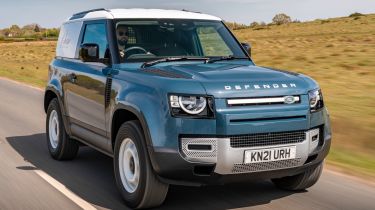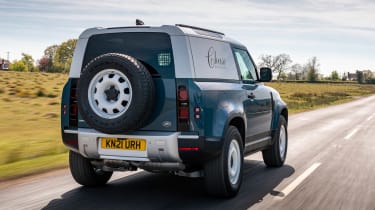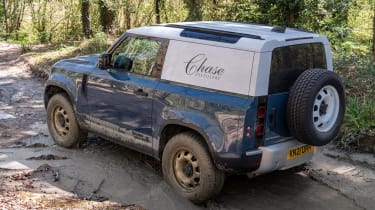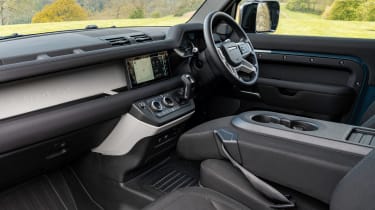Land Rover Defender Hard Top review
The cargo-carrying Defender Hard Top offers a premium image for businesses in need of a vehicle that stands out from the crowd

The Land Rover Defender range has now been bolstered by the arrival of the Hard Top, a commercial version designed for businesses needing a vehicle that can head off road and also serve as an upmarket billboard for their services.
The Defender Hard Top comes in 90 and 110 (short and long wheelbase) guises - just like the Defender SUV - but the range isn't quite as broad. The short-wheelbase Defender 90 Hard Top is only available in standard trim with the D200 six-cylinder diesel, while the 110 Hard Top is offered in standard, S, SE and HSE trims with either the D250 or D300 versions of the six-cylinder diesel. Prices start at around £37,000 excluding VAT, although the top-spec version is closer to £56,000 (ex-VAT).
That's less than the asking price of the Defender SUV, but where that car is designed for transporting people, the Defender Hard Top replaces its back seats with a large cargo area. The seats, belts and other luxuries are stripped out, and a hard plastic floor is added in their place. This stretches from the side-hinged tailgate to the back of the front seats, where Land Rover has fitted a hard plastic partition.
On the outside, the rearmost windows on both models are replaced by plastic trim. While the rear side doors on the Defender 110 are still in place, they gain heavily tinted glass, while the electric windows no longer function. Inside there is hard plastic protection for the windows for added security.
Aside from these changes, the Defender Hard Top looks identical to the SUV. That means the same broad range of options is on offer, with a wide choice of wheels, exterior, interior and seating upgrades available.
Used - available now

2023 Hyundai
Tucson
47,656 milesAutomaticPetrol1.6L
Cash £23,490
2023 Hyundai
Kona
36,830 milesManualPetrol1.0L
Cash £16,581
2023 Skoda
Fabia
11,145 milesManualPetrol1.0L
Cash £15,652
2023 Hyundai
i20
4,079 milesAutomaticPetrol1.0L
Cash £16,191Under the skin, the Defender Hard Top features the same running gear as the SUV, so you get air suspension as standard, as well as Land Rover's excellent Terrain Response system. This provides the Defender Hard Top with near-unstoppable off-road performance, much like the original Land Rover, but with a marked improvement in comfort.
One area where the Defender Hard Top stands out is in the cabin. This is carried over wholesale from the SUV, so it features the same well-equipped and high-quality interior – aside from the bulkhead directly behind the front seats, you could easily assume you're sitting in the SUV. The Defender is a two-seater, although the SUV's jump seat is available as an option to create a three-seat cabin, albeit a rather tight one.
Overall, the Land Rover Defender Hard Top is a pretty unique proposition. Its only direct rival is Land Rover's own Discovery Commercial, which offers more space and slightly different kit, but the same off-road ability. Elsewhere, the Toyota Land Cruiser Utility Commercial comes in the same long and short wheelbases and can match the Defender in the rough, but it's a much more basic proposition inside, with far less kit. Mitsubishi offers two commercial 4x4s in the shape of the Shogun Sport and Outlander PHEV, but while the latter offers low running costs, it doesn't get the same tax benefits as the equivalent SUV because of its commercial vehicle status.
Beyond that, you're looking to the one-tonne double cab pick-up truck class. These models offer heavier payloads, but while ride comfort has improved, they can't match the Defender for luxury. Still, models such as the Ford Ranger, Toyota Hilux and Isuzu D-Max are worth considering thanks to their long kit lists and competitive pricing.
MPG, CO2 and running costs
While Land Rover has its roots in the utilitarian, the brand's current image is that of a premium SUV manufacturer. The Defender Hard Top fits the latter brief, so while it's a commercial vehicle, it comes with a premium price tag that puts it around £10,000 clear of premium pick-up trucks and other rival commercial 4x4s.
But you get what you pay for, and the Defender Hard Top is an upmarket commercial vehicle that will suit businesses wishing to convey a premium image. Even the entry-level Defender 90 has that upmarket appearance, so you don't have to splash out on a 110 unless you need the extra space (it's roughly £8,000 extra, although the top-spec HSE model is nudging £56k before options).
The high costs don't stop once you've bought a Defender Hard Top. The whole range is powered by Land Rover's Ingenium six-cylinder diesel, so while they have fuel-saving mild-hybrid tech included, they're thirsty. Whether you choose the D200-powered Defender 90 Hard Top or the D250 or D300 Defender 110s, official combined WLTP fuel economy is the same, at 29.4mpg. The current WLTP tests mean that these figures are achievable, but expect them to drop if you make the most of the Defender Hard Top's payload. All Defenders come with an 89-litre fuel tank, so there's a range of more than 550 miles if you get near the official economy figure.
One area where a saving can be had is on road tax. Commercial vehicles have a fixed rate of VED, so the Defender Hard Top's emissions don't affect this. It also means the Defender Hard Top avoids the surcharge that's levied on the SUV for costing more than £40,000.
Load space & practicality
There are two body styles to choose from with the Defender Hard Top, the 90 or the 110. These numbers hark back to the classic Defender, where they used to indicate the wheelbase of each model. However, the new Defender 90 has a wheelbase that's closer in size to the old 110's (at 101.9 inches, or 2,587mm), which just shows how cars have grown in size over the decades.
As well as a shorter wheelbase, the Defender 90 also has a three-door layout. There's a hard plastic bulkhead behind the seats, so this means there's only one way in and out of the cargo area via the side-hinged back door. While the door has the spare wheel hanging off it, it's actually easy to open on its gas strut, although you need to plan on where you park to ensure you have enough space behind the car to swing it open.
The cargo area in the Defender 90 Hard Top measures 1,326mm wide (1,124mm between the wheelarches), 1,037mm long and 947mm high, and there's a cargo volume of 1.12 cubic metres on offer. The area has a grey rubber floor with plastic sides, and is a square, uniform shape - the sides use the same plastic trim as the SUV – while a flat load lip means loading should be simple. There's a 58-litre lockable under-floor storage area and the Defender's skylight windows in the edges of the roof let some light into the cargo space, too.
In comparison, the Defender 110 is slightly more interesting thanks to its extra doors. These feature opaque black tinted glass on the outside, while inside the SUV's door trim is extended up so the extra plastic covers the other side of the glass - a handy security feature. Opening the side doors also gives access to extra hidden storage where the footwells of the SUV normally are. These 155-litre spaces are accessed from above via the hinged floor, or there's side access if you've filled the main cargo area.
As with the Defender 90, the side-hinged rear door opens easily, but here it opens to reveal a cargo area of 1.7 cubic metres. The floor is longer, at 1,472mm, and there's more space between both the side doors (1,423mm) and the wheelarches (1,160mm). However, the cargo height is slightly lower, at 937mm.
Cargo length and width is a little behind that of a pick-up truck such as the Ford Ranger, and payloads are lower for the Defender Hard Top, too. While double pick-ups need to be able to carry more than a tonne of payload to qualify as a commercial vehicle, commercial 4x4s just need to be designed to carry cargo to qualify. As a result, the Defender 90 has a maximum payload weight of 670kg, while the Defender 110 maxes out at 800kg, irrespective of which engine you choose.
One area where the Defender is a match for a pick-up truck is towing. All versions can haul a 3.5-tonne trailer, which matches the best pick-ups around. Of course, if you are towing, then it'll be tricky to open the rear door while hitched, so the Defender 110 is a better option if you still need to access the cargo space.
Reliability and safety
All Defender Hard Tops come with the same three-year/unlimited mileage warranty as the rest of Land Rover's range, and there's roadside assistance cover for the same period. An extended warranty is available at extra cost that can cover the Defender Hard Top for up to 10 years.
In addition, there's a six-year anti-corrosion warranty and another one for paint that covers the same period, while any parts or accessories that are bought at the same time as the car are also covered for three years.
In terms of reliability, Land Rover doesn't have the best reputation, but with the Defender using the same electronics and running gear as other cars in the range, any software updates will be simple to add and should help the car's reliability.
Safety will be first rate, whichever way you look at it. The standard Defender SUV has a five-star Euro NCAP rating, and with the same safety kit, airbags and electronic systems on board, the Hard Top is an equally safe place to be.
Driving and performance
On the road, the Land Rover Defender Hard Top is as accomplished as the SUV. Air suspension makes for a comfortable ride that has the beating of any pick-up truck - whether you're carrying a heavy load or not - and the Defender is a top choice for anybody wanting the most comfortable commercial vehicle there is. Cabin refinement is excellent, there were some creaks from the bulkhead on the cars we drove, but it's not a deal breaker in the slightest.
Bigger wheels do unsettle the ride a little, but you'd hardly call the Defender uncomfortable, and if you've driven a classic Land Rover, the modern version is light years ahead. Where the old car has a cramped driving position that pins you to the driver's door, the new Defender is spacious, although if you add the optional jump seat and fold it down, you'll find the driver's seat is a little cramped in the opposite direction.
Light steering means the Defender is easy to manoeuvre, while front and rear parking sensors and big wing mirrors help you position this large vehicle. One useful option is Land Rover's Clearsight Rear View Mirror. When active, it swaps the standard mirror view for an image relayed from a roof-mounted camera. This is a great addition in the Hard Top, since the mirror view is obscured not only by the spare wheel on the rear door, but also the plastic mesh opening in the bulkhead.
The 3.0-litre Ingenium diesel packs a punch, even in D200 guise, and there's plenty of torque on tap. The standard eight-speed auto gearbox slips through the gears with ease, and really takes the strain out of driving.
The Defender Hard Top's showpiece is its off-road ability. The Terrain Response system is the same as you'll find in Land Rover's SUVs, and it offers electronic control of the Defender's power distribution, suspension ride height and diffs to deliver outstanding off-road ability. While other commercial vehicles can be had with four-wheel drive, nothing offers the mix of ability and comfort that a Land Rover does.
Cab and interior
The Defender Hard Top is just as plush as its SUV counterpart. There are lots of high-quality plastics, metal trim and leather on higher spec models, while the standard kit list is extensive. The main downside of the Defender when compared with the SUV version - or a double cab pick-up, for that matter - is the lack of passenger space. It's not cramped, but the Hard Top's status as a commercial vehicle means it's only a two-seater.
You can add a third 'Jump Seat' between the front seats, but cabin space is a little cramped in this layout, and there will be a lack of shoulder room if you travel three-up. A better option is to fold this seat down, where it doubles as a table with cup holders and a bank of charging sockets at the base of the seat.
You get a good view of the road ahead from behind the wheel, while extra sensors allow you to position this large 4x4 relatively easily. Light controls help here as well.
Looking for a commercial vehicle with low running costs? Read our list of the Best electric vans...

















